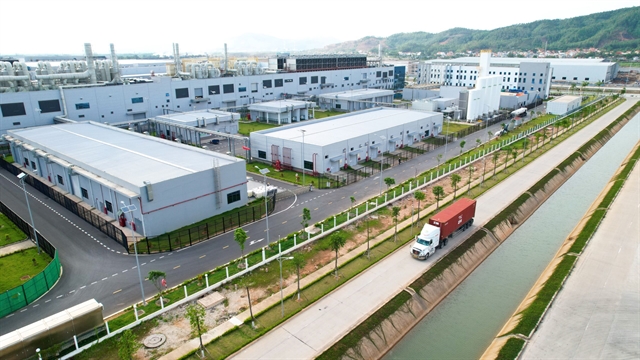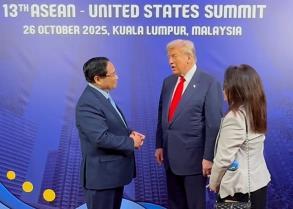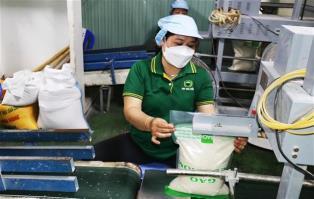Green industrialisation is no longer a matter of choice but an essential requirement for Việt Nam to stay competitive in global value chains

HÀ NỘI — As Việt Nam pursues both rapid economic expansion and its net zero pledge by 2050, industrial transformation has emerged as a critical path forward, heard attendants at the 'Green industry: harmonising high growth and sustainable development' forum held in Hà Nội on Wednesday.
Experts emphasised that green industrialisation is no longer a matter of choice but an essential requirement for Việt Nam to stay competitive in global value chains, especially as multinationals like Apple, Samsung and Nike set ESG and net zero compliance as prerequisites for partnership.
Dr Nguyễn Bá Hùng, Chief Economist of the Asian Development Bank (ADB) in Việt Nam, said green growth offers a dual opportunity: to leapfrog economically while laying the foundation for long-term sustainability.
“Green growth means transforming our economic structure to optimise natural resources, improve competitiveness, and drive innovation through advanced technologies and modern infrastructure,” he said.
According to Dr Hùng, one of the core principles of green growth is the ability to 'decouple' economic expansion from environmental degradation - growing GDP without depleting natural resources or increasing emissions.
He added: “This is the pathway advanced economies are pursuing, and Việt Nam must follow suit if it wants to sustain its position.”

Research presented at the forum showed that green industrial zones can raise labour productivity by 15–25 per cent thanks to high-tech applications, better working conditions, and stronger talent attraction. These zones, experts said, are vital for Việt Nam to deepen its integration in global value chains, particularly as Environmental, Social and Governance (ESG) regulations tighten across key export markets such as the EU and the US.
However, the transition is not without obstacles. Vietnamese enterprises, particularly small and medium-sized firms, still face major hurdles, including limited access to green finance, capacity gaps, and policy uncertainty.
“Green growth must not be misunderstood as a burden,” said Dr Bùi Thanh Minh, Deputy Director of the Private Sector Development Committee (Committee IV).
“When embraced as a long-term investment strategy, it becomes a powerful lever for breakthrough development.”
Minh pointed to sectors with transformative potential, including renewable energy, green hydrogen production, and clean industrial clusters. With an estimated 1,000 GW in renewable energy potential, Việt Nam has what it takes to become a cost-competitive green hydrogen hub. He added that green industrial clusters, where large and small firms co-locate and share clean infrastructure, will be critical in building resilient domestic supply chains.
Việt Nam is also taking ambitious steps to reach its net-zero goal by 2050, including plans to expand solar capacity to 73 GW and wind power to 38 GW by 2030, modernise its grid, deploy pumped-storage hydropower, and cut methane emissions from agriculture by 30 per cent.
However, Minh stressed that technology innovation must be at the heart of this transformation.
“Without high-tech innovation, Việt Nam cannot hope to become a high-income economy. Enterprises must pivot now,” he said.
The price tag for Việt Nam’s green transition is steep. Experts estimate that achieving net zero by 2050 will require US$360 billion in investment. Mobilising this capital will demand a robust legal framework for green credit, carbon trading, and diversified sources of sustainable finance.
Industrial reform must also go hand in hand with workforce development.
“Raising awareness on green transition and ESG practices within enterprises is critical,” said Minh.
“We must also build stronger linkages between businesses, research institutions and universities to meet labour market needs.”
Dr Chử Văn Lâm, Standing Vice Chairman of the Việt Nam Association of Economists, highlighted that after four decades of reform, Vietnam has made notable industrial gains. Ranked 42nd globally by UNIDO for industrial competitiveness, the country has moved into the upper-middle tier and now contributes over 30 per cent of GDP from industry.
“However, our current industrial model is unsustainable,” he warned, adding that the sector’s heavy reliance on FDI, accounting for over 70 per cent of export value, and traditional industries like cement, mining and metallurgy, which consume 75 per cent of fossil fuel energy, pose serious environmental and social risks.
Echoing the concern, Dr Hùng of ADB said Việt Nam risks falling behind if it cannot meet global ESG standards. “The structure of our industrial sector is heavily FDI-driven with low localisation and high carbon intensity. This undercuts both climate commitments and long-term resilience.”
While areas like green energy and transportation have seen substantial investment, speakers noted that the green industry, the foundation of Việt Nam’s manufacturing economy, still lacks a central role in national growth strategy and net-zero planning.
To address this, experts at the forum recommended a four-pillar strategy: position green industry as a national priority; build strong green financing and institutional frameworks; strengthen supporting industries; and foster innovation, skills development and technology transfer.
Industry leaders such as Panasonic, CNCTech and VietCycle showcased successful models of digitalised, circular and energy-efficient production, proving that green investments deliver both environmental and economic benefits. But the challenges remain.
Trần Đức Ninh, CEO of KN Group, warned that Việt Nam must act now.
Ninh said: “We cannot wait until we’re penalised with carbon tariffs or rejected from supply chains. Green transformation must begin immediately - starting with industry.”
As Việt Nam targets double-digit growth in 2025 and beyond, it must reconcile the twin imperatives of economic acceleration and sustainability.
Lâm summed up the challenge: “The solution doesn’t lie in trade-offs, but in choosing the right path and committing to it. Harmonisation must become the principle — not just the slogan — of our development strategy.
“In the net-zero era, where ESG is the new global benchmark, Việt Nam cannot afford to delay. Building a green, clean, self-reliant and competitive industrial base is no longer optional, it is the only way forward.” — VNS





